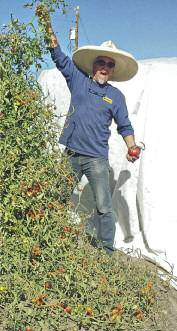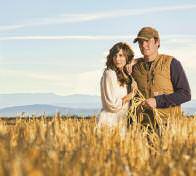edible garden
THE PURSUIT OF FRUIT
WRITTEN BY SUE EDMONDSON
PHOTOS BY CANDICE NYANDO
For vegetable gardeners, cool fall days signal the end of summer’s bounty. Not so for many Northern Nevada fruit tree growers. September kicks off harvest season for apples, pears, and late varieties of stone fruit such as plums, peaches, and nectarines.
But, in our region, the harvest sometimes doesn’t come to fruition. Trees have to survive frost when they are blossoming and stave off the cold before the fruit fully ripens. Trees also must withstand our blustery winds and pest infestations.
Trials and Tribulations
 At Agape Organics in Washoe Valley — a certified-organic, u-pick apple orchard — owners Al and Delane Pennington know the frustration of crop failure. This is the first year of the last three that their u-pick operation, The Apple Basket, will open. (For hours, visit www.Agapeorganics.com).
At Agape Organics in Washoe Valley — a certified-organic, u-pick apple orchard — owners Al and Delane Pennington know the frustration of crop failure. This is the first year of the last three that their u-pick operation, The Apple Basket, will open. (For hours, visit www.Agapeorganics.com).
“Growing fruit in Nevada can be a challenge,” says Michael Janik, arborist, educator, and tree seller, whose user-friendly website, www.Michaelsapples.com, offers tips, links, and a newsletter. “You may wait five years for a tree to mature enough for a large crop and then lose it all overnight. It does require patience.”
A few tricks
Reno resident Dr. Pat Colletti has been perfecting his apple-growing techniques since 1986. Eighty-eight organically grown trees and hundreds of grafts later, he’s a pro who even presses his own cider.
“I make some that approach a Fume Blanc,” he says, laughing. “Some approach death!”
His first trick is growing trees from a semi-dwarf rootstock, MM111.
“It does one thing no others do,” he says. “It penetrates our clay soil.”
Next, he says to properly irrigate.
“The best is a drip system,” he says. “There’s little evaporation and it sends water down to the roots.”
Another suggestion: plant trees to form a canopy.
“When trees grow over each other they cool the ground,” he says. “But prune them so they’re open to sunlight.”
Trimming Tips
Pruning is one of Janik’s expert services.
“But you can learn to do it yourself,” he says.
He teaches pruning privately, and as part of University of Nevada Cooperative Extension’s Grow Your Own Series.
Janik’s tricks include planting dwarf trees, and not only because they’re easier to maintain.
“You get twice the yield in half the space,” he says.
Deterring Pests
 Janik and the other growers agree that clearing debris reduces the opportunity for pest infestations. Borers, codling moths, aphids, and voles all can wreak havoc.
Janik and the other growers agree that clearing debris reduces the opportunity for pest infestations. Borers, codling moths, aphids, and voles all can wreak havoc.
“If you don’t take care of pests, you might as well save your water because you’ll lose the trees,” Al Pennington says.
“Look for bubbles in the bark, the sign of borers,” Colletti says. “Cut them out, then paint the spot with white latex.”
He deters voles with underground vibration devices and curbs codling moths with a virus, insecticidal soap, and Neem oil.
Delane Pennington found success with homemade moth traps.
“Mix one and one-half cups apple cider vinegar, one-eighth teaspoon ammonia, and one-third cup molasses with water to make one quart,” she says. “Cut a circle in a plastic bottle, fill, and hang from a branch.”
“The UC Davis website is an excellent resource for pest and disease control,” Janik adds. “Just Google ‘UC Davis’ along with the plant name.”
Proper Picking
Finally, learn proper harvesting techniques.
“Never pull an apple off the tree,” Colletti says. “It destroys the bud. Instead push up and rotate the apple.”
At Agape Organics, customers use kid-friendly scissors to cut the stems.
Getting started
You don’t have to be an expert to grow fruit trees, Pennington says.
“When we bought our orchard, I was a teacher,” he says. “The only thing I knew about apples was that my students gave them to me.”
For success with pears and stone fruit, Janik recommends planting Nevada-friendly varieties. A sampling includes Bartlett pears, Elberta peaches, and Stanley plums.
As to apple varieties, Colletti has one suggestion for novice growers: “Grow what you like to eat!”
Freelance writer Sue Edmondson is an avid gardener and ever-hopeful orchardist. She’s currently on the hunt for borers, voles, and moths.
RECIPE
My Favorite Apple Crumb Pie
(courtesy of Delane Pennington from Agape Organics, serves 8 to 10)
6 large organic apples (I like tart ones, but add a mixed variety for flavor)1 cup flour
1 teaspoon cinnamon
1 teaspoon baking powder
½ cup sugar
½ cup brown sugar
1 large egg
1/3 cup melted butter
½ cup chopped walnuts
1/3 cup caramel sauce
Preheat oven to 350 degrees. Grease a 2-quart baking dish. Peel, core, and thinly slice apples and spread in baking dish. In a medium-size bowl, mix flour, cinnamon, baking powder, and sugars. Beat egg slightly and stir into sugar mixture. Spoon mixture on top of sliced apples. Sprinkle with chopped walnuts and then drizzle ice cream caramel sauce over top. Pour melted butter over mixture and bake for 45 minutes. Serve warm with ice cream. Delicious!


